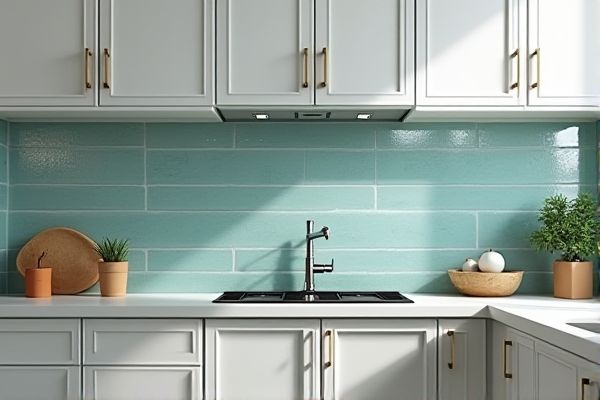
A glass backsplash offers a sleek, modern look with easy maintenance and superior stain resistance, while a tile backsplash provides versatile designs and textured finishes that can enhance the kitchen's aesthetic. Discover which option best suits Your style and functionality needs by reading the rest of the article.
Table of Comparison
| Feature | Glass Backsplash | Tile Backsplash |
|---|---|---|
| Material | Tempered glass | Ceramic, porcelain, or natural stone |
| Appearance | Sleek, glossy, modern, reflective surface | Varied textures and patterns, classic look |
| Durability | Resistant to stains and heat; can crack upon impact | Highly durable; resistant to heat and impact |
| Maintenance | Easy to clean; requires regular wiping to avoid smudges | Requires grout cleaning; may need sealing |
| Installation | Smoother installation; fewer seams | More labor-intensive; multiple grout lines |
| Cost | Higher initial cost per sq. ft. | Generally lower cost; wide price range |
| Customization | Custom colors, back-painted options | Wide variety of shapes, colors, and designs |
| Resale Value | Modern appeal can boost value | Timeless appeal with broad buyer preference |
Introduction to Backsplash Options
Glass backsplashes provide a sleek, contemporary look with reflective surfaces that brighten kitchen spaces and simplify cleaning. Tile backsplashes offer versatile design options through various colors, patterns, and textures, enhancing aesthetic appeal and durability. Both options protect walls from moisture and stains while contributing to the overall kitchen style.
What Is a Glass Backsplash?
A glass backsplash is a smooth, glossy panel made from tempered glass installed on kitchen or bathroom walls to protect surfaces from spills and stains while enhancing decor with a sleek, modern look. Unlike traditional tile backsplashes, glass backsplashes provide a seamless, grout-free surface that is easier to clean and maintain. Your choice between glass and tile backsplashes impacts not only aesthetic appeal but also durability and ease of upkeep.
What Is a Tile Backsplash?
A tile backsplash consists of individual ceramic, porcelain, or natural stone tiles arranged in a pattern to protect kitchen walls from moisture and stains. Tile backsplashes offer a wide range of colors, textures, and designs, allowing for customizable aesthetics and enhanced durability. They are heat-resistant and easy to clean, making them a popular choice for both traditional and modern kitchens.
Aesthetic Comparison: Glass vs Tile
Glass backsplashes offer a sleek, modern aesthetic with a reflective surface that enhances light and creates a sense of spaciousness in kitchens. Tile backsplashes provide a versatile range of textures, patterns, and colors, allowing for traditional, rustic, or intricate designs that suit various interior styles. While glass emphasizes minimalism and brightness, tile adds depth and character through its tactile and visual diversity.
Durability and Maintenance
Glass backsplashes offer superior resistance to stains, moisture, and heat, making them highly durable and easier to clean with minimal maintenance. Tile backsplashes, while durable, often have grout lines that require regular sealing and cleaning to prevent mold and discoloration. Choosing a glass backsplash for Your kitchen ensures a sleek, low-maintenance surface that retains its appearance longer compared to traditional tile options.
Installation Process and Complexity
Glass backsplashes require precise cutting and careful handling during installation due to their fragility and reflective surface, often necessitating professional expertise to avoid cracking or misalignment. Tile backsplashes involve a more straightforward installation process with individual pieces being easier to adjust, cut, and replace, which suits DIY enthusiasts better. Both materials demand a clean, level surface and appropriate adhesive, but glass installation complexity is comparatively higher due to the need for specialized tools and techniques.
Cost Differences
Glass backsplashes typically cost between $25 and $70 per square foot, offering a sleek, modern look but often requiring professional installation that increases total expenses. Tile backsplashes range from $5 to $50 per square foot, depending on the material and design complexity, with DIY installation options helping to reduce costs significantly. Maintenance and durability factors also influence the long-term value, with glass being more resistant to stains but potentially pricier to repair than ceramic or porcelain tiles.
Customization and Design Flexibility
Glass backsplashes offer superior customization and design flexibility with options for endless colors, patterns, and finishes, including frosted, textured, and back-painted glass, allowing seamless integration into modern and contemporary kitchens. Tile backsplashes provide versatile design possibilities through varied shapes, sizes, and grout colors, enabling intricate mosaics and traditional layouts, but may require more maintenance to keep grout lines clean. Both materials accommodate personalization, yet glass excels in creating sleek, reflective surfaces that enhance light and space.
Pros and Cons of Glass Backsplashes
Glass backsplashes offer a sleek, modern look with ease of cleaning and resistance to stains and moisture, making them ideal for kitchens and bathrooms. However, they can be prone to scratching and may require frequent wiping to maintain their glossy appearance, while installation can be more costly than tile options. Compared to tile backsplashes, glass provides a seamless surface without grout lines, reducing mold buildup but limiting design variety and texture.
Pros and Cons of Tile Backsplashes
Tile backsplashes offer a wide variety of styles, colors, and textures, making them highly customizable for any kitchen design. Their durability and resistance to heat and moisture make tiles a practical choice, but grout lines can accumulate dirt and require regular cleaning and maintenance. You may find tile backsplashes more budget-friendly compared to glass, though they can chip or crack under heavy impact.
 homyna.com
homyna.com